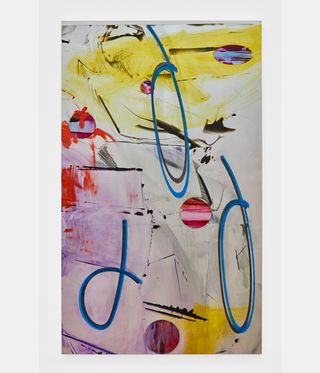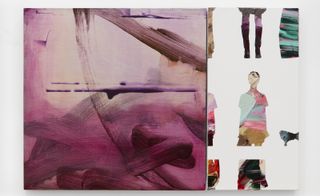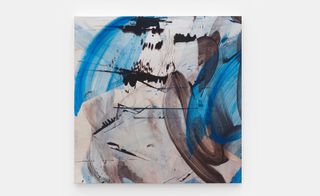Violet Dennison’s work illuminates how modern technology reshapes our minds – makes them inattentive, unpredictable, frenetic, riddled with anxiety, rotten beyond repair and endlessly fascinating. Of course, there are many artists who explore that topic, but Dennison has chosen a uniquely traditional method for delving into the follies and foibles of our disjuncted psyche – oil painting.
Dennison’s new show at Tara Downs Gallery, ‘Damaged Self’, features abstract paintings that she has, in her own words, ‘pushed into a chaotic physiological space’. ‘I was playing off more traditional abstracts, like Rothko, [where the canvas is] a meditative space,’ Dennison tells me as we walk around the Soho gallery before the opening night. ‘And here it is a menacing space. There’s an anxiety under all of it.’
It is unlikely that ‘menacing’ and ‘anxiety-inducing’ are the first words to come to mind when encountering ‘Damaged Self’; after all, the charisma of Dennison’s paintings is one of their most impressive qualities, they draw viewers in and keep them looking. But once you are looking, you start to pick up the details that hint at something darker.

Violet Dennison, LOOPS, 2024
(Image credit: Violet Dennison)
In Tilted + E-comm, for instance, Dennison uses a trompe l’oeil effect to create the appearance of an unstretched canvas, tilted and placed on top of another canvas; when really, it is all on one surface, a ‘mini-painting’ of an unstretched painting within a painting. That principal canvas is spliced through by a thinner, longer canvas that displays a grid of silhouetted models, shoes and bags lifted from an e-commerce website and made into another series of mini-paintings.
If, Dennison posits, abstract painting is about capturing its maker’s state of mind and facilitating that same state of mind in its viewer, then it needs to be updated to reflect our current psychological state, and she is down for the job. In Tilted + E-comm and other works in the show, the canvas is turned around, interrupted, made to look like something it isn’t. Its composition echoes the way we move through the world. Like the canvas, the centrality of what we see in front of us is constantly interrupted by the images on our screens, which so often display a grid, whether on social media or shopping websites, that show us things we can buy or suggest ways we should be. Grids are a recurring motif for Dennison, since the format so often serves as the blueprint for our confused desires. ‘You can throw anything on the grid – a human, a vacuum, whatever and there’s no hierarchy or reason,’ she says. ‘[These days] our mind is just instantly draw to this square space, to the grid.’

Violet Dennison, Violet Abstraction + E-comm, 2024
(Image credit: Violet Dennison)
Burnt Out! Green 1, 2, and 3 are three works on square canvases, inspired by the size of images on an Instagram grid. They feature abstracts in acid chartreuse, the same noxious shade that draws associations with Brat these days, but which Dennison chose because, even though it looks artificial, it has been used for centuries to make landscapes look more realistic.
It is another example of the artist upending expectations, asking us to reconsider what we think we know. Its lightbox-like gesso is a byproduct of Dennison ‘erased abstractions’ technique, which is even more obvious in works like Jacob’s Ladder Flower in Violet and I am trying to show you my pain but maybe it’s the wrong aesthetic 3. To create it, Dennison applies, then removes layers of paint using rags, hog hair brushes, turpentine-wetted washes and wipes. These ghostly remains of colour combine to create a screen-like glow on the canvas and to suggest a sense of movement underneath.

Violet Dennison, TBT, 2024
(Image credit: Violet Dennison)
In fact, if there is one unifying factor among all of Dennison’s work, it is that it conveys a fast, almost frenetic sense of movement. Part of this has to do with the way she works. The paintings are always made quickly, and if Dennison gets to a point where she feels the painting is no longer working, she scraps it and starts a new canvas. Before starting she creates tests, takes pictures of them, reworks them on her computer, prints them to add new details by hand, and so forth until it’s ready; and then, because of the compressed time restraints she works under, she often goes through four canvases before the work is finally complete.
‘What I love about this mode of painting is that it’s this one shot space,’ Dennison says. ‘A lot of other painters might just paint white over that and do it again, but I don’t do that. This way catches all that vulnerability.
‘Sometimes it sucks working in that way,’ Dennison laughs; but to her, being an artist requires a full, and often uncomfortable immersion, in the physiological space of your time. Only that way can an artist create work that speaks to their moment; and this moment behests work that moves fast, breaks into fragments, and tricks us all the time. ‘I think there’s a tendency in our generation to feel that things are moving so fast and to try to slow down,’ Dennison says. ‘To become “trad” or go “cottage-core” or something; but I don’t want to do that. I want to roll with the wave and embrace that speed.’
Violet Dennison’s ‘Damaged Self’, is at Tara Downs Gallery until 5 October 2024

